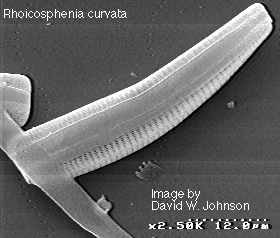Disclaimer & Copyright Notices; Optimized for the MS Internet Explorer)

Most environmental studies are done “after-the-fact”, or after a problem has already been identified (such as an acidification of a lake or development of algal blooms or fish kills due to deepwater anoxia). It is often difficult to effectively assess and treat these problems without some historical knowledge of how and when the problems originally developed.
Typical questions that a paleolimnologist might address may include: Why did the lake lose its deepwater oxygen, or was it naturally anoxic? Did the lake naturally have large algal blooms? If so, then perhaps mitigation efforts are fruitless as this is the lake’s “natural state”. At what point in time, and at what level of nutrient enrichment, did eutrophication symptoms become a problem? All these as well as many other questions need to be considered in an historical context.
As each species of diatom has its own characteristic environmental requirements (e.g., some live in acidic or alkaline waters, some thrive in either low or high nutrient levels in lakes, some like to live on aquatic macrophytes, and so on), by reconstructing past diatom populations, paleolimnologists can accurately infer past lake conditions.
Other biological indicators commonly used in paleolimnology include the scales and cysts of chrysophyte algae, shells and body parts of animals, and the chitinous exoskeletons of a large number of invertebrates. Included in the latter group are, for example, the preserved head capsules of midge larvae (chironomids), which are excellent indicators of deepwater oxygen levels.
An effective approach to studying diatom communities with respect to lake water quality is to analyze the surface-sediment diatoms from a set of lakes with complete and reliable limnological data. The surface sediments, e.g., top 1-cm interval, contain an integration of diatoms from a variety of lake habitats that have accumulated during the past few years. These surface sediments contain a wealth of information that can then be used to infer past water-quality conditions, on the basis of the percent abundances of sedimentary diatom taxa.
Detailed assessments of anthropogenic impacts on lake water quality require continuous temporal records of diatom assemblages. However, it is logistically prohibitive to analyze complete sediment cores for a large population of lakes. For large-scale studies aiming to provide regional estimates of limnological change, the most effective approach is to analyze microfossils in present-day and preindustrial sediment core samples. Differences between preindustrial and present-day inferences estimate water-chemistry changes caused by anthropogenic activity and also provide information on background or reference conditions.
This approach has been successfully used to provide regional estimates of lake water chemistry changes in the Adirondacks, New York (e.g., pH, acid-neutralizing capacity (ANC), monomeric [Al] and [DOC]), Sudbury, Ontario (pH, total [Al], [Ni], [Ca]), and the northeastern U.S.A. (pH, [TP], [Cl], Secchi depth).
Present-day (0-1 cm interval) and
preindustrial (1 cm thick interval from >20 cm core depth, and
usually >25 cm) sediment samples were removed from the cores.
Confidence that the core bottom samples represented preindustrial
(i.e., pre-1850) conditions in all lakes was expressed, because 210Pb
sediment dating from large numbers of south-central Ontario lakes
indicates that a sediment depth of 15 to 20 cm almost always represents
the pre- 1850 period. 210Pb dating from other Precambrian
Shield regions indicates that preindustrial sediment intevals are
usually located within the top 20 cm (e.g., Adirondacks).
A state-of-the-art textbook in paleolimnology:- Smol, J.P. 2008. Pollution of Lakes and Rivers: A Paleoenvironmental Perspective. 2nd ed. Blackwell Publishing, Oxford. x,383 pp. ISBN-13: 978-1-4051-5913-5.
We salute the Chebucto Community Net (CCN) of Halifax, Nova Scotia, Canada for hosting our web site, and we applaud its volunteers for their devotion in making `CCN' the best community net in the world!